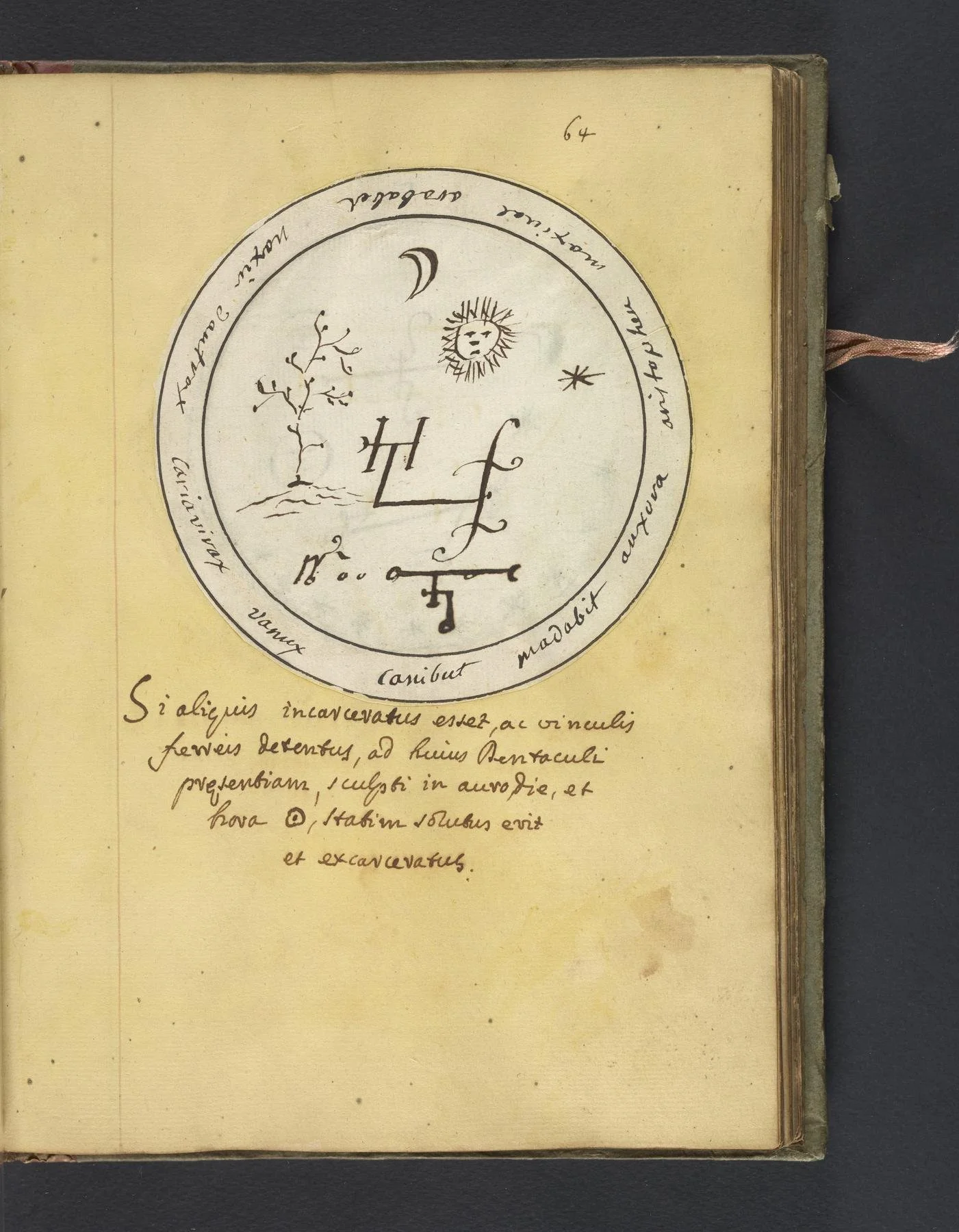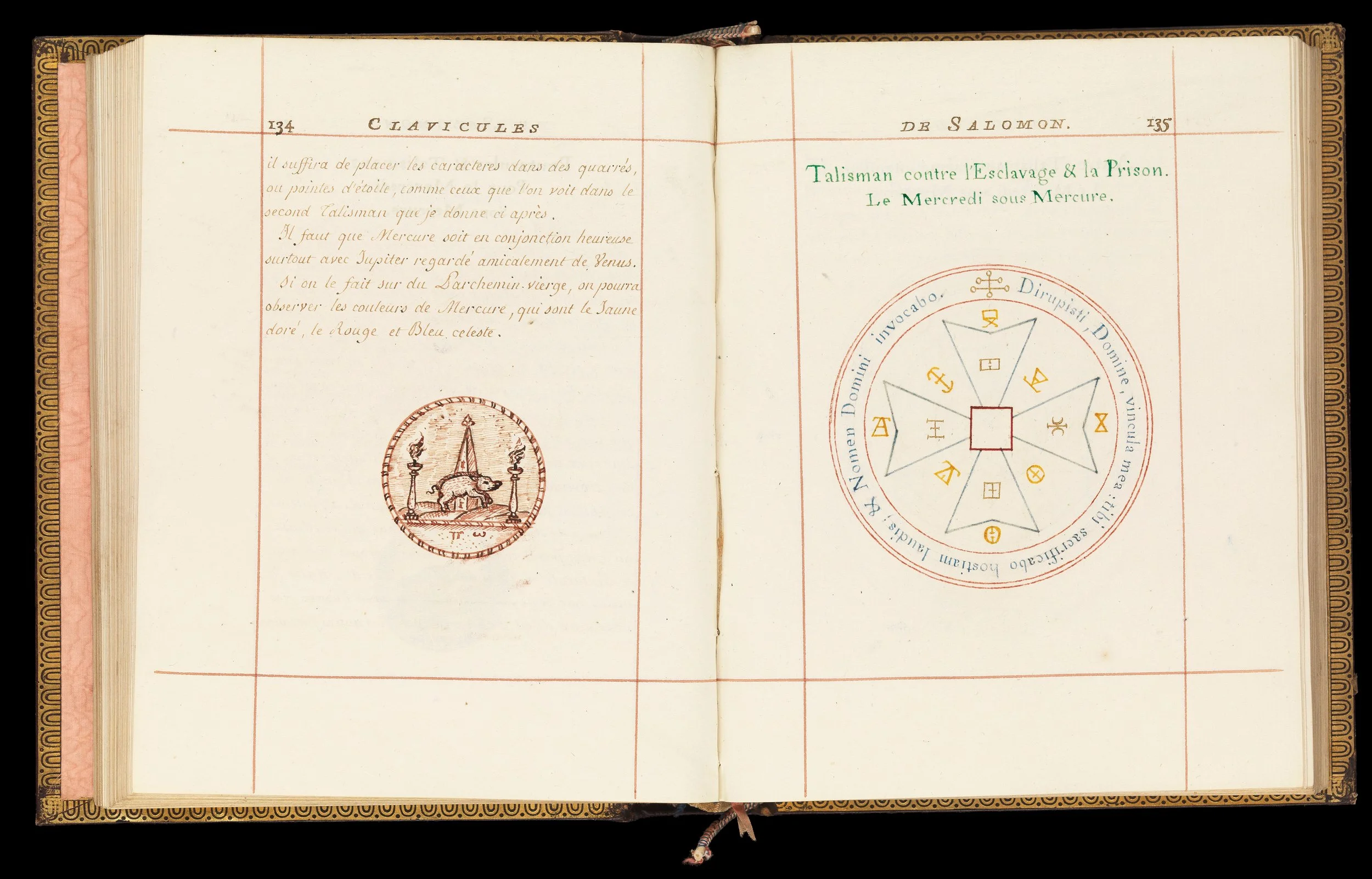Jailbreak: Two Liberatory Talismans
From Clavicula Salomonis Regis : ex idiomate Haebreo versa
Behold the handsome pentacle above, which comes from Clavicula Salomonis Regis : ex idiomate Haebreo versa. This work is attributed to Abraham Colorni, and is dated c.a. 1750-1799.
The manuscript image comes from the University of Pennsylvania’s Kislak Center for Special Collections, Rare Books and Manuscripts in Philadelphia, Pennsylvania, U.S.A. The work is also known as UPenn Ms. Codex 1673.
The Kislak material summary aids in framing this manuscript. It reads:
“18th-century Latin copy of the Key of Solomon, a 16th-century magical handbook which includes instructions on subjects such as the conjuration of spirits (f. 11r), enchanting a piece of fruit with a love charm (f. 31v), extracting bat’s blood (f. 104v), the preparation of ink, paper or parchment for magical practices (f. 105r), and the use of knives, swords, and wands (f. 96v). The text is divided into two books and contains a complete list of contents for each book (f. iii recto, 113r).”
A fascinating provenance for the manuscript itself also exists, and is listed in the material record:
“Formerly owned by Charles Rainsford (British army officer, fellow of the Royal Society, and alchemist); bequeathed by Rainsford to Hugh Percy, Second Duke of Northumberland. Owned by the 2nd through 12th Dukes of Northumberland, ms. 584, Alnwick Castle, Northumberland, 1809-2014 (bookplate, inside upper cover; stamps throughout). Sold at auction at Sotheby’s (London), 15 July 2014, as part of Lot 411.”
According to Kislak, Colorni was a:
“Jewish Italian engineer, mathematician, inventor, and archaeologist born in Mantua. He served as an engineer at the courts of noblemen such as Alfonso D’Este, Duke of Ferrara and authored works on mathematics, ciphers, and translated the Key of Solomon from Hebrew into Italian.”
Closer detail from Clavicula Salomonis Regis : ex idiomate Haebreo versa
As for the use of this pentacle, a liberatory, solar function is at play. The Latin text accompanying the image translates to:
“If one is unexpectedly detained by fierce bonds, present this pentacle made in gold on the day and hour of the sun, from hollowed out/excavated metal.”
In this instance, the sense of the word excarceratus means freed or released from prison/bond. It’s likely that a figurative element to this phrasing is at play — one denoting a freed metal: Free up some metal, free oneself (excavate), so to speak. This quality clearly reveals a correspondence between the state of metallic freedom, and the nature of one’s own carceral, spiritual, or psychic liberation.
A similar pentacle may be found in another talisman against slavery & prison. This taisman is not solar in its orientation. Rather, it is ruled by Wednesday under Mercury. It is called:
Talisman contra l’Esclavage & le Prison. Mercredi sous Mercure.
From the French to English, this reads:
“Talisman against Slavery & Prison. Wednesday under Mercury.”
From Vol. II. Les Clavicules de R.Salomon
This pentacle comes from from Vol. II. Les Clavicules de R.Salomon, translated from Hebrew into French by M. Pierre Morissoneau, a “Professor of Oriental Languages and follower of Kabbalism.” The manuscript is dated c.a. 1795, and it comes from the Wellcome Collections digital archives in London, U.K.
Wellcome’s translation of the manuscript description reads:
“The Key of Solomon… the whole enriched with a great number of mysterious figures of talismans, pentacles, circles, canderies and characters, with the method of composing them and a simple explanation of the principles of the occult science of the most famous necromancers who have lived from Solomon to the present enhanced with their most beautiful secrets. The talismans or characters of the twelve rings within which the Spirit is enclosed for all that one wants” Description via Wellcome library: “Illustrated with numerous pen-drawn magical figures, talismans, etc. in gold, silver and colours. In Vol. I the text is in red, black and green: in Vol. II the text is in similar colours, and facing the title-page is a folding figure of a magic Circle in red and green, the text in red. In both volumes there are historiated ornaments, vignettes, tail-pieces, etc., by the calligrapher who signs himself on the title-page of Vol. I ‘J. S. Fyot, ecrivain. 1796’.”
The text encircling the talisman reads:
Dirupisti, Dominae, vincula mea : tibi sacrificabo hostiam laudis; & Nomen Dominae invocabo.
To the English, this roughly reads:
“O Lord, Thou hast broken my bonds: I will sacrifice to thee the sacrifice of praise, and I will call upon the name of the Lord.”
The phrase is clearly sourced from the Biblical Psalm 116.
Talisman contra l’Esclavage & le Prison. Mercredi sous Mercure. Or, “Talisman against Slavery & Prison. Wednesday under Mercury.” From Vol. II. Les Clavicules de R.Salomon
There are many instances of liberatory talismans and pentacles throughout the various versions of the Key of Solomon, as well as the greater Western magical milieu. Such pentacles were likely used for instances of physical bondage and enslavement. Surely, one can find use for them in regards to mental or spiritual bondage as well. Either way, let these pentacles find the freedom-fighters, the disenfranchised, bonded, and imprisoned!
Bibliography:
• Colorni, Abraham. Clavicula Salomonis Regis : ex idiomate Haebreo versa (UPenn Ms. Codex 1673). c.a. 1750-1799. University of Pennsylvania. Kislak Center for Special Collections, Rare Books and Manuscripts.
• Morissoneau, M. Pierre. Vol. II. Les Clavicules de R. Salomon. c.a. 1795. Wellcome Collection. http://www.wellcome.ac.uk. Creative Commons 4.0 attribution).




